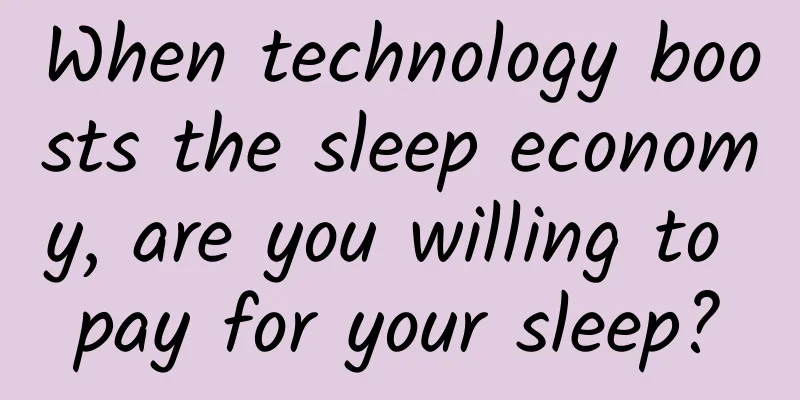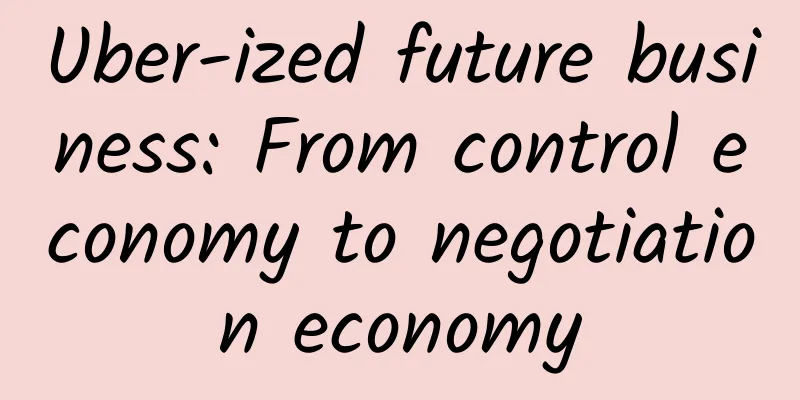When technology boosts the sleep economy, are you willing to pay for your sleep?

|
Recently, a live broadcaster named Gu Wang died suddenly due to excessive fatigue caused by lack of sleep for a long time. According to reports, the anchor started live broadcasting from 12 o'clock every night until 9 o'clock the next morning. He lived all night for several months, which eventually led to excessive fatigue and death. Nowadays, the fast-paced life and work have brought a lot of pressure to people. Under pressure, modern people generally have poor sleep quality problems, which makes modern people more prone to depression, cancer, obesity, hypertension and other diseases, and even directly leads to death. In order to make people aware of the importance of sleep, the International Mental Health and Neuroscience Foundation launched a global sleep event in 2001 and designated March 21 of each year as World Sleep Day. Under such circumstances, the business opportunities caused by sleep problems have also attracted the attention of enterprises. Due to the large population base suffering from sleep problems, the sleep economy market that can be developed is also huge. After seeing the business opportunities, entrepreneurs have begun to flock to this industry. The concept of "sleep economy" has begun to emerge, and technology will naturally become the key point of its development. The huge sleep market brings unlimited possibilities to the sleep economy According to the 2017 China Sleep Quality Report, 69.4% of Chinese residents have poor sleep quality, which not only harms people's health, but also has a negative impact on economic development. According to the RAND survey report, the United States suffers about $411 billion in economic losses each year due to insufficient sleep and poor sleep quality among office workers. The harm caused by insufficient sleep to economic development is obvious. Sleep aid products that are closely related to sleep also have a huge development market. According to the survey data of the research company Canalys, in the second quarter of this year, the shipment volume of Xiaomi wristbands reached 3.7 million units, and this year's Double Eleven also achieved good results. This Xiaomi wristband, which can detect the user's sleep status and provide health data, has been very popular among consumers since it was launched. However, the only drawback is that the Xiaomi wristband can only be used in conjunction with a Xiaomi mobile phone and APP, which means that consumers have to spend more on other products after buying the Xiaomi wristband. In addition to the Xiaomi wristband, Dapu.com, which focuses on home textiles, has launched a sleep aid product, the "Dapu Smart Anti-Snoring Pillow", which is also a hot-selling product in the sleep home market. With the help of the sleep economy, there is no shortage of technology-assisted sleep products such as Xiaomi wristbands, smart anti-snoring pillows, and sleep chairs on the market, which have become the main force in the sleep market. In an era of rapid technological development, high technology has not only improved people's quality of life, but also promoted the development of the sleep economy. By applying high technology to sleep products, consumers can have a new sleep experience. The advancement of technology is promoting the intelligent development of sleep products. Nowadays, "getting a good night's sleep" has become a luxury. People are vigorously developing sleep aids suitable for current sleep problems. "Artificial intelligence + health" has become the latest model for people to pursue high-quality sleep. By coordinating AI technology with medical care, psychology and other fields, insomniacs can be analyzed and treated to improve the efficiency of solving sleep problems. The addition of AI technology has increased the market value of sleep products by several levels. The development of the emerging sleep economy, led by science and technology, will bring about a new round of consumer market segmentation. The sleep market is worth hundreds of billions of dollars, and the product categories involved are diverse. In addition to traditional drug-assisted sleep methods, there are also smart sleep-aid products that use sound (such as the Little Sleep APP, Snail Sleep, etc.), home (anti-snoring pillows, deep sleep silk, etc.), light sensing (PEGASI smart sleep glasses), etc. Since this year, the scope of the sleep industry has become wider and wider, becoming an emerging industry with almost universal participation, and a new economic growth point in my country's health consumption field. In addition to expanding the variety of sleep-aid products, consumers' requirements for high-quality sleep are becoming more and more clear, and the development of the sleep economy under the blessing of technology is in a state of continuous rise. Behind the huge market are the pain points of the sleep economy that cannot be concealed The huge demographic dividend and the widespread sleep problems among people have brought the possibility of large-scale development of the sleep economy. However, due to the influence of various factors, even though modern people have a general understanding of the importance of sleep, there is still no better solution. The sleep economy still faces many difficulties in developing smoothly. First, sleep-aid products are passive, and consumers' use of sleep-aid products mainly depends on their subjective consciousness. Buying sleep products cannot force consumers to fall asleep on time. If consumers continue to do what they want, then the existence of sleep-aid products that rely entirely on personal subjective consciousness will be useless. In today's mobile Internet era, people still keep their phones in their hands until the last second before going to bed, and sleep-aid products cannot play a good role, which limits the further development of the sleep economy. Second, high-tech sleep aids are expensive and unaffordable for ordinary consumers. For example, MetroNaps, a company that has been vigorously developing sleep products, independently developed a semi-enclosed sleep chair called "EnergyPod", which costs as much as $12,000. Faced with such a high price, many consumers can only stay away, which greatly affects the sales of the product and is not conducive to the promotion and popularization of the product. High-quality sleep should never be a privilege for a few people, and sleep products have yet to be implemented. Third, there are many sleep aid products of varying quality in the sleep product market, deceiving consumers. There are many types of products in the sleep consumer market, and it is difficult for consumers to distinguish the authenticity of goods, especially sleep aid products. Generally speaking, sleep products can be divided into health care and medical types. The development of health care sleep aid products is not yet mature and is still in the exploratory stage. In order to seek high profits, some companies produce a large number of low-quality sleep aid products, resulting in the emergence of many "fake and empty" products with poor quality in the sleep product market. Fourth, many products on the market do not provide accurate data when testing sleep quality and health conditions. Some high-tech products will start up with a slight touch, which will cause users to have erroneous data analysis, such as the Xiaomi bracelet. Furthermore, some consumers rely too much on high-tech sleep aids, and force themselves to use the products in order to obtain good data, which will affect sleep quality. In addition, in addition to the problem of inaccurate data, these sleep products also lack professional medical judgment. Take the Dapu smart anti-snoring pillow as an example. It can be used for mild snoring, but if the snoring is severe, it will aggravate the condition, but the product itself is not rigorous in judging the degree. At present, the development of the sleep economy is still difficult. In addition to solving the problem of people's lack of attention to sleep and the high cost of high-tech research and development, it is also necessary to regulate the consumer market of sleep products. These problems are difficult to be solved in a short period of time, and they still need to be solved through continuous investigation and research. However, it is undeniable that the sleep economy has broad development prospects. In the huge sleep market, how can sleep aid products control the market? Nowadays, with the development of economy and the upgrading of consumption, people pay more and more attention to the health of their body. The aspects related to physical health are mainly reflected in eating, moving and sleeping. In terms of "eating" and "moving", people can take the initiative to eat a reasonable diet and exercise appropriately to obtain corresponding health protection, but in terms of "sleeping", people are in a passive state of being powerless. If companies want to make good products and promote the development of sleep economy, they must start from solving the pain points of sleep. First, on the basis of helping people sleep, we should enhance consumers’ experience and enjoyment of the products. Nowadays, no matter what industry it is, we focus on providing consumers with a good experience. The most important function of sleep products is to help people sleep, but when developing sleep products, we need to pay attention to the experience that the products bring to consumers. For example, we can develop sleep products suitable for different groups of people according to different regions and living habits. For example, the south is hotter, so we can add the function of heat dissipation to the development of sleep aid products, while in the north, we can add the function of heat gathering. The temperature of the product can be adjusted by the surface temperature. Secondly, we should strengthen the analysis and detection functions of sleep products and accelerate the integration of high-tech development and sleep products. Currently, many sleep products on the market have errors in detecting sleep quality and analyzing health conditions, which still depends on the development of science and technology. Technology and sleep products have formed an inseparable relationship. Only by accurately analyzing the data of sleep products can we grasp the pain points of consumers, accurately understand the sleep quality and health conditions of users, and provide corresponding solutions based on actual conditions. Finally, in addition to the sleep-inducing effect, sleep-aid products should also have other diverse functions. Some high-tech sleep-aid products are relatively expensive, and consumers should not only pay high prices for sleep-aid products that have the function of making people "sleep". When developing sleep products, companies should also consider adding some auxiliary functions on the basis of promoting sleep, such as relieving tension, relieving fatigue, and relieving pain caused by lack of sleep. Nowadays, people are paying more and more attention to the sleep economy. Although there are problems such as high costs, inaccurate data analysis, and uneven quality in the current sleep product market, people's attention to sleep health is promoting the reform of sleep product technology applications and strengthening the role of sleep products in sleep. High-quality and high-experience sleep products are a new pursuit of consumers in the big health industry. In today's era, which is like pressing the "fast forward button", how many people will pay for their sleep just for a "healthy body" that cannot be quickly effective? Liu Kuang, uses Zen to comprehend the Internet, WeChat public account: liukuang110 As a winner of Toutiao's Qingyun Plan and Baijiahao's Bai+ Plan, the 2019 Baidu Digital Author of the Year, the Baijiahao's Most Popular Author in the Technology Field, the 2019 Sogou Technology and Culture Author, and the 2021 Baijiahao Quarterly Influential Creator, he has won many awards, including the 2013 Sohu Best Industry Media Person, the 2015 China New Media Entrepreneurship Competition Beijing Third Place, the 2015 Guangmang Experience Award, the 2015 China New Media Entrepreneurship Competition Finals Third Place, and the 2018 Baidu Dynamic Annual Powerful Celebrity. |
>>: 91 Ten Articles: Daily Must-Read Briefing for the New Energy Vehicle Industry 210315
Recommend
A fitness blogger revealed that she had six uterine fibroids due to stress. Experts remind us: Uterine fibroids "prefer" these three types of people
Sports health blogger Zhou Liuye Zoey, who has 9....
Ten marketing trends for 2022
At the end of 2019, there was a very popular joke...
Only Yueme has no future: OTT market needs to improve cooperation capabilities to survive
Just after the 2015 Spring Festival, rumors began...
Use with caution! The "magic weapon" that cools down in one second is actually a "walking gas tank"
The weather is getting hotter Many car owners are...
Android 14 first exposure: flip the cake
Recently, some of the first submission codes rela...
Special planning of the "Health from Food" series丨Beware of "diseases from the mouth", be careful when eating these foods
Did you know that common foods in our daily lives...
The nucleic acid test sampling cotton swab contains carcinogens? Here comes the rumor debunking!
[This issue's rumors]: Recently, rumors that ...
How much does it cost to be an agent of a designated driver app in Lishui?
How much does the Lishui driver agency app cost? ...
6-month-old baby early education training course video full set (56 episodes) Baidu cloud download
6-month-old baby early childhood training course ...
Microsoft may add network speed test function to Bing search
Microsoft Bing is developing very well in the Uni...
International Albinism Awareness Day丨Today, let’s learn about the “Moon Child”
Are there some "special" people around ...
The number of mobile Internet users in my country reached 986 million, with annual access traffic reaching 165.6 billion GB
As smartphone prices drop and mobile Internet bec...
Baidu covets the mobile phone market: Is iQiyi just a pathfinder?
Yesterday, iQIYI held a press conference in Beiji...
Do you think this belly button is a bit scary?
There are many strange phobias in the world, such...
Mantou New Media Operation Certificate Class
A millionaire trader will teach you the core skil...









